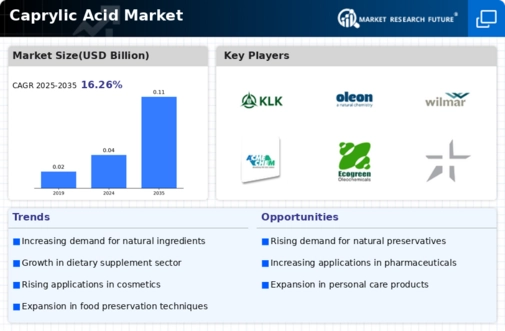Top Industry Leaders in the Caprylic Acid Market

The competitive landscape of the Caprylic Acid market is marked by intense rivalry among key players, each vying for a larger share in this rapidly growing industry. Caprylic acid, a fatty acid derived from coconut or palm oil, finds extensive applications in various industries, including food and beverages, pharmaceuticals, and personal care products. As the demand for natural and sustainable ingredients rises, the market for caprylic acid is witnessing robust growth, attracting both established companies and new entrants.
The strategies adopted by these key players revolve around product innovation, strategic partnerships, and geographical expansion. Product development remains a critical focus, with companies investing in research and development to enhance the quality and functionality of their caprylic acid products. Strategic partnerships with suppliers, distributors, and end-users are instrumental in expanding the market reach and ensuring a steady supply chain. Geographical expansion allows companies to tap into new and emerging markets, taking advantage of the growing demand for caprylic acid in various regions.
Market share analysis in the caprylic acid industry is influenced by several factors. Product quality, pricing strategies, distribution networks, and brand reputation play pivotal roles in determining the market share of each player. Additionally, the ability to adapt to changing regulatory environments and consumer preferences is crucial for sustained growth. As consumers increasingly prioritize natural and sustainable ingredients, companies that align their products with these trends are likely to gain a competitive edge.
In recent years, new and emerging companies have entered the caprylic acid market, contributing to the competitive dynamics. These companies often bring innovative solutions, challenging established players and driving overall market growth. Examples include Green Biologics, a bio-based specialty chemicals company, and VVF LLC, a global manufacturer of personal care and pharmaceutical ingredients. These entrants leverage advancements in technology and sustainable practices to carve a niche in the competitive landscape.
Industry news reflects the dynamic nature of the caprylic acid market, with frequent announcements of product launches, partnerships, and mergers. For instance, news of a strategic alliance between a leading caprylic acid producer and a prominent food and beverage company can significantly impact market dynamics. Regulatory developments, such as approvals for novel applications of caprylic acid, also shape the competitive landscape by opening up new opportunities for players.
Current company investment trends in the caprylic acid market highlight a strong focus on sustainability and technological advancements. Companies are investing in green technologies to produce caprylic acid from renewable sources, aligning with the increasing demand for eco-friendly products. Additionally, investments in research and development aim to enhance the efficiency and versatility of caprylic acid, allowing it to address evolving consumer needs across various industries.
Overall, the competitive scenario in the caprylic acid market is characterized by a blend of established players, new entrants, and technological innovators. As the industry continues to witness robust growth, companies must stay agile and adaptive to capitalize on emerging opportunities. With consumer preferences shifting towards natural and sustainable products, the companies that successfully navigate these trends and invest in innovation are poised for long-term success in the competitive caprylic acid market.
Key Companies in the Caprylic Acid market include.
- Oleon
- Wilmar International
- Acme Chem
- Ecogreen Oleochemicals
- Hallstar
- Pacific Oleo chemicals
- Solazyme
- VVF











